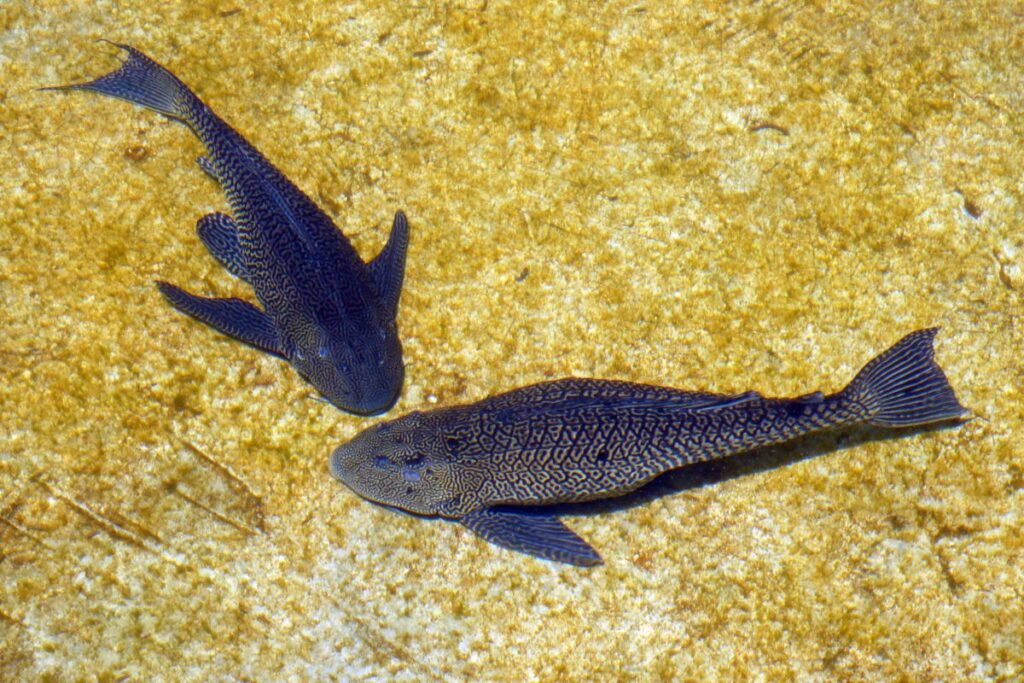Have you ever wondered if your pleco is male or female? I know I have! When I first got my pleco, I had no idea how to determine its gender. It wasn’t until I did some research that I learned the telltale signs. In this article, we’ll explore the different methods for determining if your pleco is male or female.
Males may have longer and thicker pectoral fins, and may develop bristles on their cheeks or along their body. Females may have a rounder belly and a shorter, wider head. However, the only way to determine the sex of a pleco with certainty is through breeding behavior or a venting procedure performed by a veterinarian or experienced aquarist.
It’s important to know the gender of your pleco for a few reasons. First, if you have multiple plecos in the same tank, it’s important to know their genders to prevent breeding. Second, male and female plecos have slightly different physical characteristics, so knowing the gender can help you better care for your fish. Finally, some people simply want to know the gender of their pleco for curiosity’s sake.
There are a few different methods for determining the gender of your pleco, including examining physical characteristics, observing behavior, and looking at the vent area. We’ll cover each of these methods in detail and provide tips for accurately determining the gender of your pleco. So, let’s dive in!

Table of Contents
Key Takeaways:
- Knowing the gender of your pleco is important for preventing breeding, better care, and curiosity.
- Physical differences such as body shape, fins, and genital papilla are reliable methods for determining gender.
- Behavioral differences such as territorial behavior and breeding behavior can also give clues about gender.
- Other methods of determining gender include observing breeding behavior, venting, and DNA testing.
- Determining gender may not always be easy, especially for beginners, but with patience and careful observation, it is possible.
- It is best to research the specific species of pleco you have to determine the best way to determine its gender.
Physical Differences
| Physical Difference | Male Pleco | Female Pleco |
|---|---|---|
| Body Shape | Slimmer, more streamlined | Rounder, wider |
| Fins | Longer and more pointed, especially pectoral and dorsal fins | Shorter and rounder |
| Genital Papilla | Longer and more pointed | Shorter and rounder |
Body Shape
One of the most obvious physical differences between male and female plecos is their body shape. Males tend to have a slimmer and more streamlined body shape, while females are often rounder and wider. This difference is most noticeable when viewing the fish from above.
Fins
The fins of male and female plecos can also differ in shape and size. Males typically have longer and more pointed fins, especially their pectoral and dorsal fins.
Females, on the other hand, tend to have shorter and rounder fins. However, it’s important to note that the shape and size of fins can vary depending on the species of pleco.
Genital Papilla
Perhaps the most reliable way to determine the sex of a pleco is to look at the genital papilla, which is located near the ventral fin.
In males, the genital papilla is longer and more pointed, while in females it is shorter and rounder.
However, this method requires a trained eye and can be difficult to do with young or small plecos.
When I first got my plecos, I was eager to know their sex. I did some research and learned about the physical differences between males and females.
It was interesting to observe my plecos and see how their body shape, fins, and genital papilla differed.
It’s important to note that these differences can vary depending on the species of pleco, so it’s always best to do your research and consult with an expert if you’re unsure.
Behavioral Differences
| Behavioral Difference | Male Pleco | Female Pleco |
|---|---|---|
| Territorial Behavior | More territorial and aggressive | More docile and peaceful |
| Breeding Behavior | Builds nests, chases females, may become more aggressive | Lays eggs when ready to breed, may clean a particular spot in the tank |
One of the most common questions that pleco owners ask is whether their pleco is male or female.
While it can be difficult to determine the sex of a pleco just by looking at it, there are some behavioral differences that can give you a clue.
Territorial Behavior

Male plecos are known for being more territorial than females. They may become aggressive towards other fish in the tank, especially if they feel that their territory is being threatened.
If you notice your pleco chasing other fish or becoming overly aggressive, there’s a good chance that it’s a male.
On the other hand, female plecos tend to be more docile and peaceful. They may still have their own preferred hiding spots in the tank, but they are less likely to become aggressive towards other fish.
Breeding Behavior
If you’re interested in breeding plecos, it’s important to know the sex of your fish. Male plecos will often display breeding behavior, such as building nests or chasing females around the tank.
They may also become more aggressive during breeding season.
Female plecos, on the other hand, will lay eggs when they are ready to breed. You may notice them cleaning a particular spot in the tank or laying eggs on a flat surface.
Personally, I have a male pleco in my tank and I’ve noticed that he can be quite territorial at times. He has his own little cave that he likes to hide in, and he’s not too keen on other fish getting too close.
However, he’s also a great addition to my tank and I love watching him swim around and explore.
Other Methods of Determining Gender
| Method | Description | Accuracy | Difficulty |
|---|---|---|---|
| Observing Breeding Behavior | Observe territorial and aggressive behavior in males, passive behavior in females | Low | Easy |
| Venting | Examine genital papilla | High | Difficult |
| DNA Testing | Test DNA for sex chromosomes | Near 100% | Expensive |
Observing Breeding Behavior
One way to determine the gender of your pleco is by observing their breeding behavior. Male plecos will often exhibit territorial and aggressive behavior when it comes to mating, while females tend to be more passive.
Males will also chase females around the tank and may try to push them into a cave or other hiding spot to spawn.
However, it’s important to note that not all plecos will exhibit this behavior, and it can be difficult to determine gender based solely on breeding behavior.
Venting
Venting is a method of determining gender that involves examining the genital papilla of the pleco.
This method is more accurate than observing breeding behavior, but it requires a certain level of expertise and can be stressful for the fish.
To vent a pleco, you’ll need to gently hold it upside down and apply pressure to its abdomen to evert the genital papilla. Males will have a pointed papilla, while females will have a rounder, more blunt papilla.
DNA Testing
For those who want a more definitive answer, DNA testing is also an option. DNA testing can determine the sex of a pleco with near 100% accuracy.
However, it can be expensive and may not be necessary for most hobbyists.
When I was trying to determine the gender of my pleco, I tried observing breeding behavior and venting, but I wasn’t confident in my ability to accurately determine the sex.
I ultimately decided to forego DNA testing and simply enjoy my pleco for its unique personality and beauty.
Recommended Products:
- API Freshwater Master Test Kit: This test kit is useful for monitoring the water quality in your pleco’s tank, which is important for maintaining good health and preventing illness. The kit includes tests for pH, ammonia, nitrite, and nitrate levels.
- Tetra Whisper Air Pump: This air pump helps to increase oxygen levels in the tank, reducing the risk of oxygen deficit and promoting healthy breathing in plecos. This can be especially important during breeding season.
- AquaClear Power Filter: This filter is useful for maintaining a clean and healthy environment for your pleco. It provides mechanical, chemical, and biological filtration, helping to remove waste and debris from the water and keep it clean and clear.
- Hikari Algae Wafers: These wafers are a great source of nutrition for plecos, providing a balanced diet that includes vegetables and protein. They can be especially helpful during breeding season, when plecos need extra nutrition.
- Aquarium Net: A net is useful for catching and moving your plecos, especially during breeding season when they may need to be moved to a separate breeding tank.
Conclusion
After observing the physical characteristics and behavior of your pleco, you can determine whether it is male or female. Remember to take note of the size, color, and shape of the pleco, as well as its behavior and breeding habits.
Based on my personal experience, I found it difficult to determine the gender of my pleco at first. However, after closely observing its behavior and physical characteristics, I was able to determine that it was a male.
This knowledge helped me provide the appropriate care and attention to my pleco, ensuring that it lived a healthy and happy life.
It is important to note that determining the gender of a pleco may not always be easy, especially for beginners.
However, with patience and careful observation, you can learn to identify the gender of your pleco and provide it with the best possible care.
“Learn how to keep your pleco healthy and happy with our Pleco Care 101 guide – the ultimate resource for all pleco owners!”
FAQs
Here are some frequently asked questions about determining the gender of plecos:
Q: Can I determine the gender of my pleco just by looking at it?
A: Unfortunately, it is not always possible to determine the gender of a pleco just by looking at it. Some species have clear physical differences between males and females, while others do not. In some cases, you may need to observe your pleco’s behavior or wait until it reaches maturity to determine its gender.
Q: How can I tell if my pleco is a male or female?
A: The method for determining the gender of a pleco varies depending on the species. Some plecos have physical differences, such as differences in fin shape or coloration, that can help you determine their gender. Others may exhibit different behaviors or develop different physical characteristics as they mature. It is best to research the specific species of pleco you have to determine the best way to determine its gender.
Q: Can I breed my plecos if I don’t know their gender?
A: It is possible to breed plecos without knowing their gender, but it is not ideal. Breeding pairs should ideally consist of one male and one female, to ensure successful reproduction. If you are unsure of your plecos’ gender, it may be best to seek the advice of a veterinarian or experienced breeder.
My personal anecdote:
When I first got my pleco, I was convinced it was a male based on its size and behavior. However, as it grew older, it began to exhibit behaviors that were more typical of females, such as nesting and guarding eggs. It wasn’t until I did some research on the specific species that I realized my pleco was actually a female.
Reference: Wikipedia.
